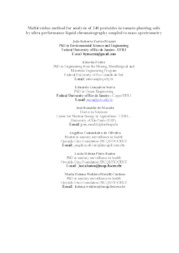Multiresidue method for analysis of 240 pesticides in tomato planting soils by ultra performance liquid chromatography coupled to mass spectrometry.
Multiresidue method for analysis of 240 pesticides in tomato planting soils by ultra performance liquid chromatography coupled to mass spectrometry.
Author(s): MAZZEI, J. R. F.; FREIRE, E.; SERRA, E. G.; MACEDO, J. R. de; OLIVEIRA, A. C. de; BASTOS, L. H. P.; CARDOSO, M. H. W. M.
Summary: In this work, an analytical method for the determination of residues was optimized for the focus pesticides: Azoxystrobin, Boscalid, Carbendazim, Chlorantraniliprole, Clothianidin, Diafenthiuron, Difenoconazole, Dimethomorph, Spinetoram, Spinosad A, Spinosad D, Fenuron, Imidacloprid, Indoxacarb, Metalaxyl M, Methoxyfenozide, Thiamethoxan in soil derived from the tomato crop, to compare the contamination levels of these compounds in samples. The modified QuEChERS extraction method and Ultra Performance Liquid Chromatography coupled to Sequential Mass Spectrometry were used (CLUE-MS/MS), with an electronebulization ionization source in ESI (+/-) mode. The method consisted of extracting 15.0 g of soil with 15 mL of saturated calcium hydroxide solution pH 12.3 and 15 mL of acetonitrile, with consequent partitioning in a "salting out" effect using 6.0 g anhydrous magnesium sulfate and 1.5 g sodium chloride. The phases were separated by centrifugation at 3700 rpm for 7 min. Linearity between 0.2 and 20.0 ug L-1, coefficients of determination greater than 0.99. The LOQ values for the method were 13 ug kg-1 for Spinosad and 7.0 ug kg- 1 for the other pesticides. The method showed good precision, with RSD values < 20%, and accuracy, with recoveries between 70 and 120% for the vast majority of the compounds analyzed. The analytical curves were prepared with reference blank soil extracts to minimize the Matrix Effect. The method was found to be suitable for the analysis of pesticide residues in the soil since it meets the validation parameters for chromatographic methods (European Comission, 2018). After validation, the method was used for residue analysis of these pesticides in soil samples from conventional, organic, and sustainable tomato crops. Making it possible to compare the levels of environmental impacts generated. In addition to validating the analytical method for the pesticides that were the focus of the study, validation was also achieved for another 240 compounds, including those authorized and those not authorized for use on tomato crops.
Publication year: 2021
Types of publication: Paper in annals and proceedings
Unit: Embrapa Soils
Keywords: Contaminants in soils, Pesticide residues, QuEChERS, UPLC-MS/MS
Observation
Some of Embrapa's publications are published as ePub files. To read them, use or download one of the following free software options to your computer or mobile device. Android: Google Play Books; IOS: iBooks; Windows and Linux: Calibre.
Access other publications
Access the Agricultural Research Database (BDPA) to consult Embrapa's full library collection and records.
Visit Embrapa Bookstore to purchase books and other publications sold by Embrapa.

